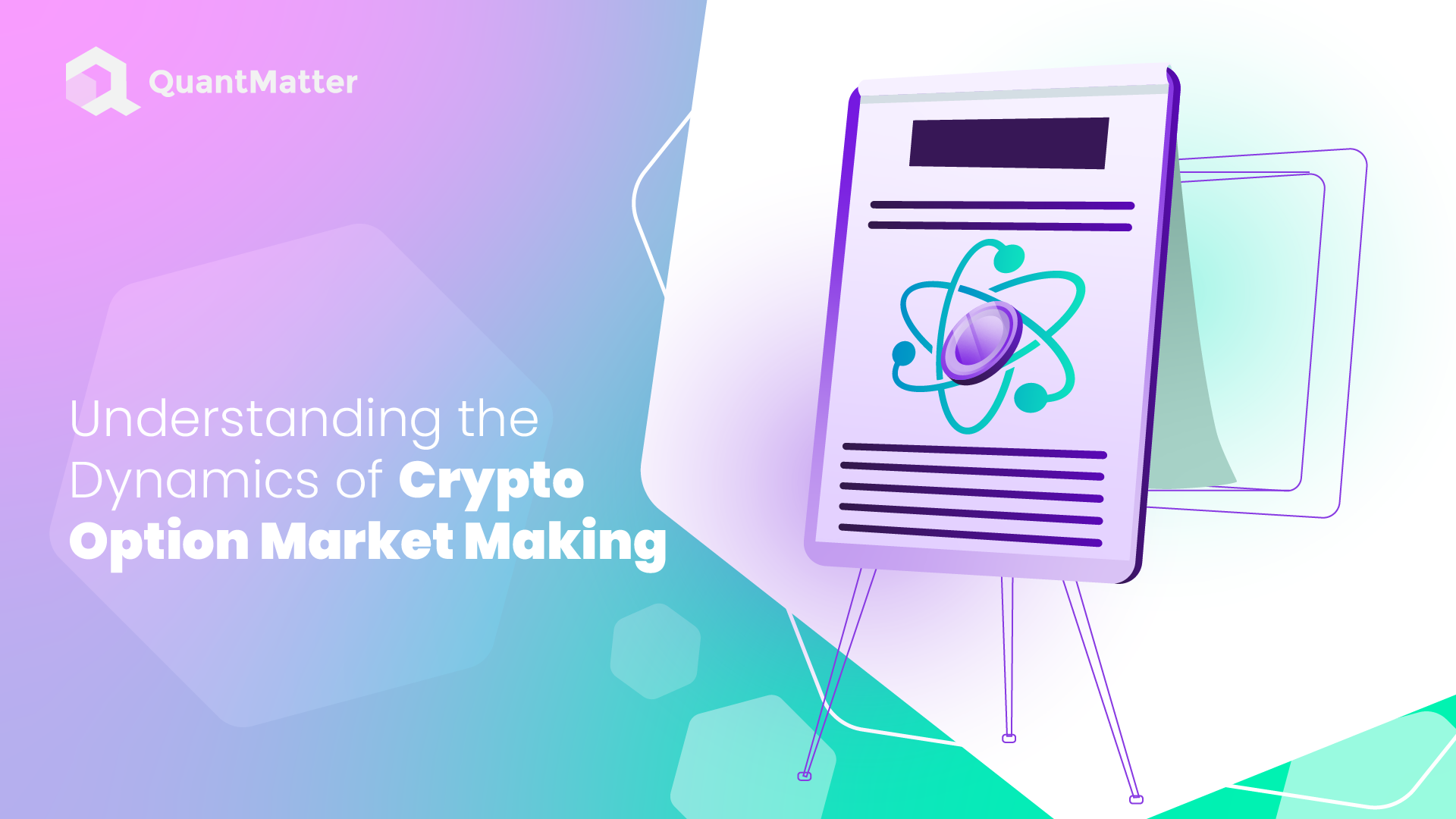
The world of cryptocurrency has witnessed rapid growth and innovation in recent years, with various financial instruments emerging to meet the demands of investors and traders. One such instrument that has gained significant popularity is crypto options. Crypto options provide traders with the opportunity to speculate on the future price movement of cryptocurrencies, offering both potential profits and risk management capabilities.
In this article, we will delve into crypto options trading, the dynamics of market making. We will explore the basics of market making, the strategies employed in the crypto option market, and the factors that affect market making in this particular space.
What Are Crypto Options?

Before we dive into market making, let’s first understand what crypto options are. A crypto option is a derivative contract that gives the holder the right, but not the obligation, to buy or sell a specified amount of cryptocurrency at a predetermined price (the strike price) within a specified time period (the expiration date). Crypto options can be categorized into two types: call options and put options.
A call option gives the holder the right to buy the underlying cryptocurrency at the strike price, while a put option gives the holder the right to sell the underlying cryptocurrency at the strike price. These options provide traders with the flexibility to profit from both upward and downward price movements of cryptocurrencies.
Also read: 10 Best Crypto Market Maker 2023
The Basics of Market Making

Market making plays a crucial role in ensuring liquidity and efficient price discovery in financial markets. In the context of crypto options, market makers are entities or individuals that provide continuous buy and sell quotes for options contracts. They effectively act as intermediaries between buyers and sellers, offering liquidity and enabling smooth trading.
Market makers profit from the bid-ask spread, which is the difference between the price at which they are willing to buy (bid) and the price at which they are willing to sell (ask) options contracts. By providing liquidity and facilitating trading, market makers earn this spread as compensation for the risks they undertake.
The basics of market making can be further expanded and itemized as follows:
1. Providing Continuous Quotes
Market makers in the crypto option market are responsible for offering continuous buy and sell quotes for options contracts. They ensure that there is always a two-way market, meaning there is both a bid (buy) and an ask (sell) price available for traders. This continuous quoting allows for uninterrupted trading and enhances market liquidity.
2. Acting as Intermediaries
Market makers act as intermediaries between buyers and sellers in the crypto option market. When a trader wants to buy or sell an options contract, they can execute the trade with the market maker, who stands ready to fulfill the trade at the quoted prices. This intermediary role helps streamline the trading process and ensures that there is always a counterparty available for market participants.
3. Providing Liquidity
Liquidity is a vital aspect of financial markets, including the crypto option market. Market makers contribute to liquidity by providing a constant supply of options contracts for traders to buy or sell. Their continuous presence in the market helps reduce the impact of large orders on prices and enables traders to execute their trades more efficiently.
4. Managing Bid-Ask Spread
Market makers profit from the bid-ask spread, which is the difference between the price at which they are willing to buy and the price at which they are willing to sell options contracts. They offer competitive bid and ask prices that are based on various factors, such as the prevailing market conditions, volatility, and trading volume. The bid-ask spread compensates market makers for the risks they assume and the services they provide.
5. Risk Management
Market makers actively manage their positions to mitigate risks associated with price fluctuations and market volatility. They continuously monitor the market and adjust their quotes and positions accordingly. For example, if a market maker sells a call option, they may hedge their position by buying the underlying cryptocurrency or a put option to offset potential losses if the price rises. By managing risks effectively, market makers ensure their operations remain sustainable.
6. Price Discovery
Market makers contribute to efficient price discovery in the crypto option market. As they continuously quote bid and ask prices based on their assessment of market conditions, their actions provide valuable information about the current supply and demand dynamics. This helps establish fair market prices and ensures that options contracts are priced in line with the prevailing market sentiment.
7. Market Efficiency
The presence of market makers enhances overall market efficiency. Their continuous quoting, provision of liquidity, and active risk management contribute to reducing spreads and transaction costs. Additionally, market makers help minimize price disparities between different exchanges by providing arbitrage opportunities and maintaining consistency in prices across platforms.
Market Making Strategies for Crypto Options

Market makers employ various strategies to manage their positions and maximize profitability in the crypto option market.
Market making strategies for crypto options involve a range of approaches to effectively manage positions and optimize profitability. Here, we will explore some of the common strategies employed by market makers in the crypto option market:
Delta-Neutral Strategy
The delta-neutral strategy is widely used by market makers to minimize exposure to price movements and maintain a balanced position. Delta represents the sensitivity of an option’s price to changes in the underlying asset’s price. Market makers adjust their portfolio by dynamically buying or selling the underlying cryptocurrency and options contracts to offset changes in delta. By staying delta-neutral, market makers aim to hedge their risks and ensure a more stable position.
Liquidity Provision Strategy
Market makers actively provide liquidity by continuously quoting bid and ask prices for options contracts. They monitor market conditions such as the underlying cryptocurrency’s price, volatility, and trading volume to adjust their quotes accordingly. By offering tight bid-ask spreads and ensuring there is always a buyer or seller in the market, market makers enhance liquidity and facilitate smoother trading.
Spread Trading Strategy
Spread trading involves taking positions in multiple options contracts to capitalize on the price differentials between them. Market makers identify opportunities where the bid-ask spread of one contract is relatively wider or narrower compared to another contract with similar characteristics. They simultaneously buy the contract with a narrower spread and sell the contract with a wider spread, aiming to profit from the convergence of the spreads.
Volatility Trading Strategy
Volatility is a key factor in the pricing and risk management of options. Market makers may employ volatility trading strategies to take advantage of fluctuations in implied volatility levels. They may adjust their quotes and positions based on changes in volatility, such as widening spreads during periods of heightened volatility and tightening spreads when volatility is low. These strategies allow market makers to adapt to market conditions and potentially profit from volatility swings.
Order Flow Monitoring
Market makers closely monitor the order flow in the market to gauge investor sentiment and anticipate future price movements. By analyzing the incoming orders and their impact on prices, market makers can adjust their quotes and positions accordingly. This strategy enables market makers to react quickly to changing market dynamics and optimize their trading strategies.
Risk Management and Position Sizing
Effective risk management is a crucial aspect of market making strategies. Market makers carefully assess and manage their exposure to market risks, including price movements, volatility, and liquidity risks. They implement position sizing techniques to ensure their overall portfolio remains within predefined risk limits. By diversifying their positions and setting appropriate risk parameters, market makers can mitigate potential losses and maintain a more stable trading operation.
Technology and Automation
Market makers often leverage advanced trading technologies and algorithms to enhance efficiency and execute trades with speed and accuracy. Automated systems enable market makers to respond to market changes in real-time and manage a large number of positions simultaneously. These technologies also facilitate the monitoring of market data, order flow, and risk parameters, enabling market makers to make informed decisions and optimize their trading strategies.
Factors Affecting Crypto Option Market Making
Several factors can impact market making in the crypto option market. One crucial factor is volatility. Higher volatility implies larger price swings and greater uncertainty, which can lead to wider bid-ask spreads and increased risks for market makers. As a result, market makers may adjust their quotes and reduce their exposure during periods of heightened volatility.
Another factor is liquidity. Market makers need sufficient trading volume and depth in the market to ensure they can enter and exit positions smoothly. Limited liquidity can make it challenging for market makers to provide tight bid-ask spreads, resulting in wider spreads and potentially lower trading activity.
Additionally, regulatory considerations and market structure can also influence market making in the crypto option space. Regulations surrounding cryptocurrencies and derivative markets can impact the participation of market makers and the overall liquidity in the market. Market structure, such as the presence of multiple exchanges and fragmentation of liquidity, can also affect market making dynamics.
Also read: What is Crypto Treasury Management?
Conclusion
Crypto options have emerged as a popular financial instrument in the cryptocurrency space, offering traders the opportunity to profit from price movements while managing risk. Market makers play a vital role in ensuring liquidity and efficient trading in the crypto option market. They employ various strategies to manage their positions and adapt to market conditions.
Understanding the dynamics of crypto option market making is crucial for traders and investors looking to participate in this market. By comprehending the basics of market making, the strategies employed, and the factors that affect market making dynamics, market participants can make more informed decisions and navigate the crypto option market with greater confidence.

I'm Carina, a passionate crypto trader, analyst, and enthusiast. With years of experience in the thrilling world of cryptocurrency, I have dedicated my time to understanding the complexities and trends of this ever-evolving industry.
Through my expertise, I strive to empower individuals with the knowledge and tools they need to navigate the exciting realm of digital assets. Whether you're a seasoned investor or a curious beginner, I'm here to share valuable insights, practical tips, and comprehensive analyses to help you make informed decisions in the crypto space.
- Carinahttps://quantmatter.com/author/carina/
- Carinahttps://quantmatter.com/author/carina/
- Carinahttps://quantmatter.com/author/carina/
- Carinahttps://quantmatter.com/author/carina/
